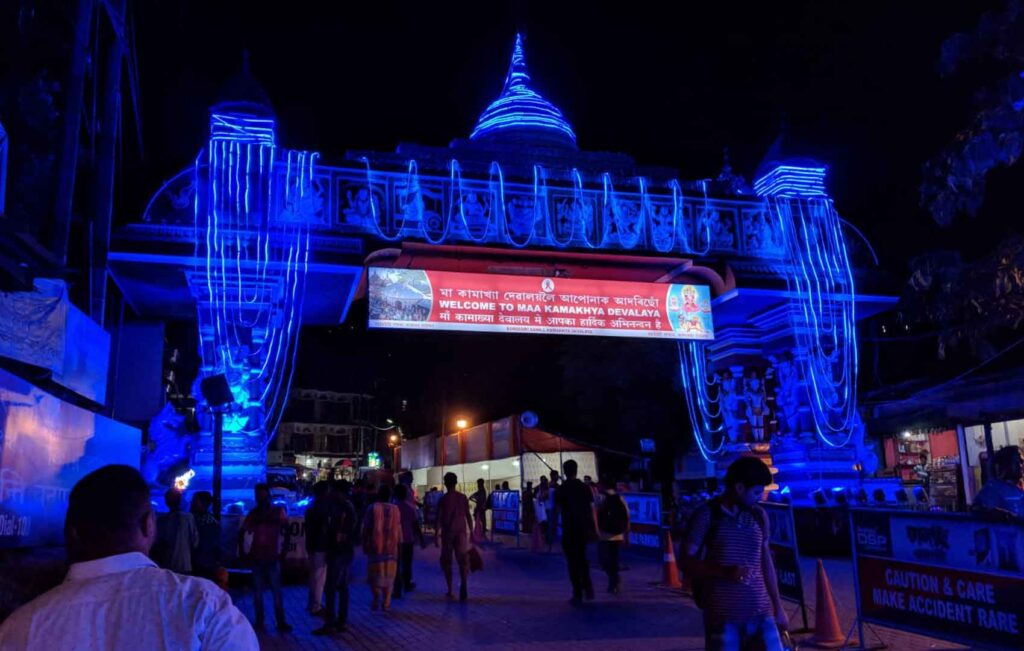
Introduction:
Nestled within a bustling urban landscape, Kamakhya Devi Temple graces the Nilachal Hill in Guwahati, city often referred to as the Gateway to Northeast India. This sacred shrine is not just a place of worship but also a testament to the rich cultural heritage and spiritual significance of the northeastern region of India.
In this blog, we invite you to embark on a virtual journey, allowing us to guide you through the sacred corridors of Kamakhya Temple, even from afar –
Kamakhya Temple holds immense sanctity in Hinduism, being revered as one of the 51 Shakti Peethas according to Hindu Mythology. It occupies a prominent place as one of the original (Adi) Shakti Peethas and ranks among the esteemed eighteen Maha Shakti Peethas.
Gathered by throngs of devotees daily, Kamakhya Temple is one of the oldest Shakti Peeths on the earth.
It is one of the best places to visit in Guwahati.
The primary reason for the majority of visitors to Guwahati is to seek the divine blessings of Kamakhya Devi by paying a visit to this revered temple.
Kamakhya Temple is not just spiritually significant; it is also architecturally captivating.
Ambubachi Mela:
One of the most famous festivals associated with Kamakhya Temple is the Ambubachi Mela, which takes place annually in June. According to Hindu mythology, during these three days, it is believed that the goddess undergoes her annual period of menstruation, and as a result, the temple remains closed for that duration. The temple reopens on the fourth day, signifying the goddess’s renewal and rejuvenation. This unique and sacred observance highlights the importance of feminine power and the natural cycles of life. It challenges societal taboos associated with menstruation, turning the ordinary into the extraordinary. It is a celebration of the divine feminine, embracing the power and vitality that is often overlooked or stigmatized.
The Ambubachi Mela draws thousands of devotees and seekers from various parts of India and beyond. Pilgrims come to seek the blessings of Goddess Kamakhya, and Tantric practitioners gather to perform rituals during this auspicious time. Sadhus and yogis, including those who practice Tantra, find the festival spiritually significant and engage in meditation, prayers, and various rituals during this period.
Ambubachi Mela at Kamakhya Temple is a truly remarkable celebration, transcending boundaries and shattering taboos surrounding menstruation. It symbolizes the power of the divine feminine and the cyclical nature of life. The festival is a fascinating blend of spirituality, culture, and mysticism that showcases India’s rich heritage and spiritual diversity.
Visiting Ambubachi Mela provides a unique opportunity to witness and participate in a festival that embraces the natural rhythms of life, and it stands as a testament to the profound and multifaceted spirituality that continues to thrive in India.
Conclusion:
Kamakhya Temple is not just a place of worship; it is a living symbol of the divine feminine, a hub of mysticism, and a testament to the rich cultural and religious diversity of India. Visiting this temple is a unique and spiritually enriching experience, and it offers an opportunity to delve into the mystical realms of Hinduism, Tantra, and the goddess Kamakhya. It stands as a testament to the timeless devotion and the enduring mystique that makes India a land of spiritual discovery.
